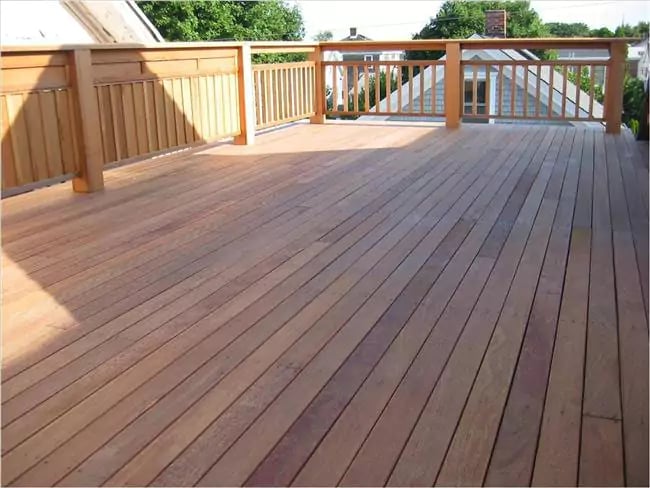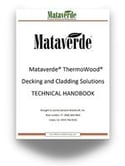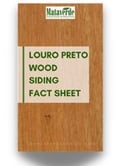
Technical Resources Directory
Decking and Siding Materials, Rainscreen Siding, Wood Properties
Have questions about wood decking, siding types, or installation?
This directory is designed to help architects, contractors, and homeowners quickly and easily locate and download technical information about exterior woods, decking, siding, and lumber. Download these resources for your project planning, design, and construction needs.
If you don't see your question answered here please contact our team, we are happy to help.
EXTERIOR WOODS
|
HOW EXTERIOR HARDWOODS WEATHER Learn how exterior wood ages and how to care for it. |
CRITICAL WOOD ACCLIMATION GUIDELINES Do's-and-don'ts for properly acclimating your material.
|
|
EXTERIOR WOOD CARE AND MAINTENANCE Low maintenance premium hardwood guidelines
|
MATAVERDE® GLOSSARY OF TERMS Definition of decking, lumber, and siding terminology.
|
|
HARDWOOD DECKING INSTALLATION How-tos and guidelines for a quality deck build. FINISHING OPTIONS FOR EXTERIOR HARDWOODS High density wood needs special, but easy, finishing.
|
CHECKING AND CRACKING IN HEAVY TIMBERS Techniques to help minimize this natural occurrence. to Selecting The Right Decking
|
|
|
|
|
|
|
THERMALLY MODIFIED WOODS
Mataverde® Thermowood Ash
|
THERMOWOOD ASH TECHNICAL DATA SHEET For Thermowood decking and cladding
|
THERMOWOOD ASH QUALITY DEFINITIONS about Thermowood decking and cladding materials |
|
THERMOWOOD ASH TECHNICAL HANDBOOK And research for decking and siding.
|
THERMOWOOD ASH CARE AND MAINTENANCE Guidelines for Thermowood decking and siding
|
Mataverde® ThermaWood Hem-Fir
|
THERMAWOOD HEM-FIR BROCHURE Features of Therma Wood decking and siding. |
THERMAWOOD INSTALLATION AND CARE Install and maintenance tips for Thermawood decking.
|
FLAME RESISTANCE
|
|
|
|
IWUI LISTING FOR MATAVERDE® THERMAWOOD FR HEM-FIR FIRE TREATED WOOD ESR-1159 WUI Evaluation Report |
WUI LISTING FOR MATAVERDE® THERMAWOOD FR HEM-FIR FIRE TREATED WOOD From the California Dept. of Forestry and Fire Protection. |
MATAVERDE® IPE CLASS A FIRE RATING Certification Testing Inspection for Ipe wood. |
MATAVERDE® CUMARU CLASS A FIRE RATING Certification Testing Inspection for Cumaru wood. |
|
MATAVERDE® MACHICHE CLASS A FIRE RATING Certification Testing Inspection for Machiche wood. |
MATAVERDE® JATOBA CLASS A FIRE RATING Certification Testing Inspection for Jatoba wood. |
WOOD SPECIES FACTS
Wood Decking Species
|
IPE WOOD DECKING FACT SHEET Ipe decking characteristics and properties. |
MACHICHE WOOD DECKING FACT SHEET Machiche wood characteristics and properties. |
|
GARAPA WOOD DECKING FACT SHEET Garapa decking characteristics and properties. |
JATOBA WOOD DECKING FACT SHEET Jatoba decking characteristics and properties. |
|
CUMARU WOOD DECKING FACT SHEET Cumaru decking characteristics and properties. |
SANTA MARIA DECKING FACT SHEET Santa Maria characteristics and properties. |
|
MASSARANDUBA DECKING FACT SHEET Massaranduba characteristics and properties. |
Wood Siding Species
|
IPE WOOD SIDING FACT SHEET Ipe siding characteristics and properties.
|
FSC® MACHICHE WOOD SIDING FACT SHEET Machiche siding characteristics and properties.
|
|
GARAPA WOOD SIDING FACT SHEET Garapa Ipe siding characteristics and properties.
|
JATOBA WOOD SIDING FACT SHEET Jatoba siding characteristics and properties.
|
|
CUMARU WOOD SIDING FACT SHEET Cumaru siding characteristics and properties.
|
FSC® SANTA MARIA WOOD SIDING FACT SHEET Santa Maria siding characteristics and properties.
|
|
FSC® MASSARANDUBA WOOD SIDING FACT SHEET Massaranduba siding characteristics and properties.
|
FSC® LOURO PRETO WOOD SIDING FACT SHEET Louro Preto siding characteristics and properties.
|
|
THERMAWOOD SIDING FACT SHEET ThermaWood Hem Fir siding characteristics and properties.
|
THERMOWOOD SIDING FACT SHEET Thermowood Ash siding characteristics and properties.
|
|
WOOD RAINSCREEN SIDING MATERIALS CHART Compare popular woods for use with Climate-Shield®.
|
RAINSCREEN SIDING INSTALLATION
|
BUILDER'S RAINSCREEN PROJECT CHECKLIST A tool kit to help install Climate-Shield® Rainscreen.
|
CLIMATE SHIELD® INSTALLATION: HORIZONTAL For over OSB or Plywood, a step-by-step guide.
|
|
CLIMATE SHIELD® INSTALLATION: VERTICAL For over OSB or Plywood, a step-by-step guide.
|
CLIMATE SHIELD® INSTALLATION: Over Gypsum or Masonry, a step-by-step guide.
|
|
CLIMATE SHIELD® INSTALLATION: Z-GIRTS
A step-by-step guide. |
PURA NFC ® SIDING by TRESPA
|
PURA NFC ® SIDING BROCHURE Full color brochure from Trespa.
|
PURA NFC ® TEST RESULTS MDS Material Data Sheet
|
|
TRADITIONAL PURA NFC SIDING INSTALLATION Guidelines for horizontal siding installation for Trespa.
|
HORIZONTAL PURA NFC RAINSCREEN SIDING Guidelines for horizontal CST1 system installation.
|
|
VERTICAL PURA NFC RAINSCREEN SIDING Guidelines for the Vertical CST1 system installation.
|
Easier Installation of Pura NFC ® with CST1 Watch:
|
FAQ LINKS


